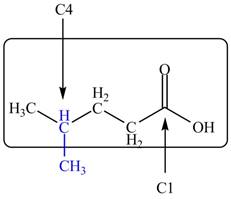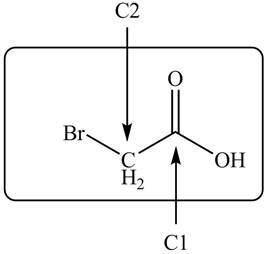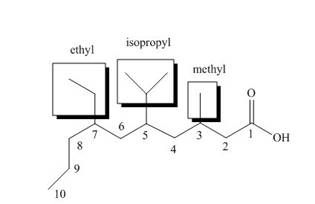
Give the IUPAC name for each compound.
a.
 h.
h. ![]()
b.
c.  f.
f.  i.
i. 
d.
 j.
j. 
(a)
Interpretation: The IUPAC name for each compound is to be stated.
Concept introduction: International Union of Pure and Applied Chemistry gave guidelines to write the chemical name of molecules. One should follow the given three steps to derive the structure of the compound from its IUPAC name. The first step involves the identification of the parent name and the functional group found at the end of the name. The second step is numbering of carbon skeleton in either direction. The third step is the addition of substituents at appropriate carbon atoms.
Answer to Problem 19.28P
The name of the compound is
Explanation of Solution
The structure of the given compound is shown below.

Figure 1
The above compound has a chain of five carbon atoms. The carboxylic acid is present as a functional group in the compound. One methyl group is present at the fourth carbon atom. Therefore, the name of the compound is
The name of the compound is
(b)
Interpretation: The IUPAC name for each compound is to be stated.
Concept introduction: International Union of Pure and Applied Chemistry gave guidelines to write the chemical name of molecules. One should follow the given three steps to derive the structure of the compound from its IUPAC name. The first step involves the identification of the parent name and the functional group found at the end of the name. The second step is numbering of carbon skeleton in either direction. The third step is the addition of substituents at appropriate carbon atoms.
Answer to Problem 19.28P
The name of the compound is
Explanation of Solution
The structure of the given compound is shown below.

Figure 2
The above compound has a chain of two carbon atoms. The carboxylic acid is present as a functional group in the compound. One bromo group is present at the second carbon atom. Therefore, the name of the compound is
The name of the compound is
(c)
Interpretation: The IUPAC name for each compound is to be stated.
Concept introduction: International Union of Pure and Applied Chemistry gave guidelines to write the chemical name of molecules. One should follow the given three steps to derive the structure of the compound from its IUPAC name. The first step involves the identification of the parent name and the functional group found at the end of the name. The second step is numbering of carbon skeleton in either direction. The third step is the addition of substituents at appropriate carbon atoms.
Answer to Problem 19.28P
The name of the compound is
Explanation of Solution
The structure of the given compound is shown below.

Figure 3
The above compound has a chain of eight carbon atoms. The carboxylic acid is present as a functional group in the compound. Two methyl groups are present at thefourth carbon atom and two methyl groups are present at the fifth carbon atom. Therefore, the name of the compound is
The name of the compound is
(d)
Interpretation: The IUPAC name for each compound is to be stated.
Concept introduction: International Union of Pure and Applied Chemistry gave guidelines to write the chemical name of molecules. One should follow the given three steps to derive the structure of the compound from its IUPAC name. The first step involves the identification of theparent name and the functional group found at the end of the name. The second step is numbering of carbon skeleton in either direction. The third step is the addition of substituents at appropriate carbon atoms.
Answer to Problem 19.28P
The name of the compound is lithium butanoate.
Explanation of Solution
The structure of the given compound is shown below.

Figure 4
The above compound has a chain of five carbon atoms. The compound contains the salt of carboxylic acid as a functional group. Therefore, the name of the compound is lithium butanoate.
The name of the compound is lithium butanoate.
(e)
Interpretation: The IUPAC name for each compound is to be stated.
Concept introduction: International Union of Pure and Applied Chemistry gave guidelines to write the chemical name of molecules. One should follow the given three steps to derive the structure of the compound from its IUPAC name. The first step involves the identification of theparent name and the functional group found at the end of the name. The second step is numbering of carbon skeleton in either direction. The third step is the addition of substituents at appropriate carbon atoms.
Answer to Problem 19.28P
The name of the compound is
Explanation of Solution
The structure of the given compound is shown below.

Figure 5
The above compound contains cyclopentyl ring. The carboxylic acid is present as a functional group in the compound. Ethyl group is attached to first carbon atom. Therefore, the name of the compound is
The name of the compound is
(f)
Interpretation: The IUPAC name for each compound is to be stated.
Concept introduction: International Union of Pure and Applied Chemistry gave guidelines to write the chemical name of molecules. One should follow the given three steps to derive the structure of the compound from its IUPAC name. The first step involves the identification of the parent name and the functional group found at the end of the name. The second step is numbering of carbon skeleton in either direction. The third step is the addition of substituents at appropriate carbon atoms.
Answer to Problem 19.28P
The name of the compound is
Explanation of Solution
The structure of the given compound is shown below.

Figure 6
The above compound contains cyclohexyl ring. The carboxylic acid is present as a functional group in the compound. One methyl group is present at the second carbon atom and other at the fourth carbon atom. Therefore, the name of the compound is
The name of the compound is
(g)
Interpretation: The IUPAC name for each compound is to be stated.
Concept introduction: International Union of Pure and Applied Chemistry gave guidelines to write the chemical name of molecules. One should follow the given three steps to derive the structure of the compound from its IUPAC name. The first step involves the identification of theparent name and the functional group found at the end of the name. The second step is numbering of carbon skeleton in either direction. The third step is the addition of substituents at appropriate carbon atoms.
Answer to Problem 19.28P
The name of the compound is
Explanation of Solution
The structure of the given compound is shown below.

Figure 7
The above compound contains an aromatic ring. The carboxylic acid is present as a functional group in the compound. The bromogroupis attached to second carbon atom. Therefore, the name of the compound is
The name of the compound is
(h)
Interpretation: The IUPAC name for each compound is to be stated.
Concept introduction: International Union of Pure and Applied Chemistry gave guidelines to write the chemical name of molecules. One should follow the given three steps to derive the structure of the compound from its IUPAC name. The first step involves the identification of theparent name and the functional group found at the end of the name. The second step is numbering of carbon skeleton in either direction. The third step is the addition of substituents at appropriate carbon atoms.
Answer to Problem 19.28P
The name of the compound is
Explanation of Solution
The structure of the given compound is shown below.

Figure 8
The above compound contains an aromatic ring. The carboxylic acid is present as a functional group in the compound. The ethyl group is attached to fourth carbon atom. Therefore, the name of the compound is
The name of the compound is
(i)
Interpretation: The IUPAC name for each compound is to be stated.
Concept introduction: International Union of Pure and Applied Chemistry gave guidelines to write the chemical name of molecules. One should follow the given three steps to derive the structure of the compound from its IUPAC name. The first step involves the identification of theparent name and the functional group found at the end of the name. The second step is numbering of carbon skeleton in either direction. The third step is the addition of substituents at appropriate carbon atoms.
Answer to Problem 19.28P
The name of the compound is sodium
Explanation of Solution
The structure of the given compound is shown below.

Figure 9
The above compound contains the chain of six carbon atoms. The salt of a carboxylic acid is a functional group in the compound. Methyl group is attached to second carbon atom. Therefore, the name of the compound is sodium
The name of the compound is sodium
(j)
Interpretation: The IUPAC name for each compound is to be stated.
Concept introduction: International Union of Pure and Applied Chemistry gave guidelines to write the chemical name of molecules. One should follow the given three steps to derive the structure of the compound from its IUPAC name. The first step involves the identification of theparent name and the functional group found at the end of the name. The second step is numbering of carbon skeleton in either direction. The third step is the addition of substituents at appropriate carbon atoms.
Answer to Problem 19.28P
The name of the compound is
Explanation of Solution
The structure of the given compound is shown below.

Figure 10
The above compound contains a chain of ten carbon atoms. The carboxylic acid is a functional group in the compound. The methyl, isopropyl andethyl groupsare attached to third, fifth and seventh carbon atom respectively. Therefore, the name of the compound is
The name of the compound is
Want to see more full solutions like this?
Chapter 19 Solutions
Organic Chemistry
- V Biological Macromolecules Drawing the Haworth projection of an aldose from its Fischer projection Draw a Haworth projection of a common cyclic form of this monosaccharide: H C=O HO H HO H H OH CH₂OH Explanation Check Click and drag to start drawing a structure. Xarrow_forwardComplete the mechanismarrow_forwardComplete the mechanismarrow_forward
- 8 00 6 = 10 10 Decide whether each of the molecules in the table below is stable, in the exact form in which it is drawn, at pH = 11. If you decide at least one molecule is not stable, then redraw one of the unstable molecules in its stable form below the table. (If more than unstable, you can pick any of them to redraw.) Check OH stable HO stable Ounstable unstable O OH stable unstable OH 80 F6 F5 stable Ounstable X Save For Later Sub 2025 McGraw Hill LLC. All Rights Reserved. Terms of Use | Privacy C ཀྭ་ A F7 매 F8 F9 4 F10arrow_forwardJust try completing it and it should be straightforward according to the professor and TAs.arrow_forwardThe grading is not on correctness, so if you can just get to the correct answers without perfectionism that would be great. They care about the steps and reasoning and that you did something. I asked for an extension, but was denied the extension.arrow_forward
 ChemistryChemistryISBN:9781305957404Author:Steven S. Zumdahl, Susan A. Zumdahl, Donald J. DeCostePublisher:Cengage Learning
ChemistryChemistryISBN:9781305957404Author:Steven S. Zumdahl, Susan A. Zumdahl, Donald J. DeCostePublisher:Cengage Learning ChemistryChemistryISBN:9781259911156Author:Raymond Chang Dr., Jason Overby ProfessorPublisher:McGraw-Hill Education
ChemistryChemistryISBN:9781259911156Author:Raymond Chang Dr., Jason Overby ProfessorPublisher:McGraw-Hill Education Principles of Instrumental AnalysisChemistryISBN:9781305577213Author:Douglas A. Skoog, F. James Holler, Stanley R. CrouchPublisher:Cengage Learning
Principles of Instrumental AnalysisChemistryISBN:9781305577213Author:Douglas A. Skoog, F. James Holler, Stanley R. CrouchPublisher:Cengage Learning Organic ChemistryChemistryISBN:9780078021558Author:Janice Gorzynski Smith Dr.Publisher:McGraw-Hill Education
Organic ChemistryChemistryISBN:9780078021558Author:Janice Gorzynski Smith Dr.Publisher:McGraw-Hill Education Chemistry: Principles and ReactionsChemistryISBN:9781305079373Author:William L. Masterton, Cecile N. HurleyPublisher:Cengage Learning
Chemistry: Principles and ReactionsChemistryISBN:9781305079373Author:William L. Masterton, Cecile N. HurleyPublisher:Cengage Learning Elementary Principles of Chemical Processes, Bind...ChemistryISBN:9781118431221Author:Richard M. Felder, Ronald W. Rousseau, Lisa G. BullardPublisher:WILEY
Elementary Principles of Chemical Processes, Bind...ChemistryISBN:9781118431221Author:Richard M. Felder, Ronald W. Rousseau, Lisa G. BullardPublisher:WILEY





